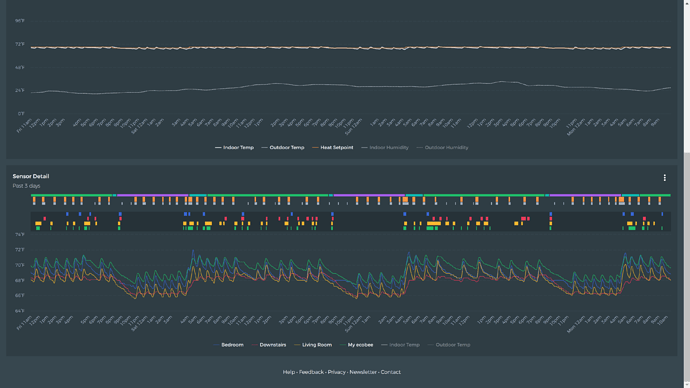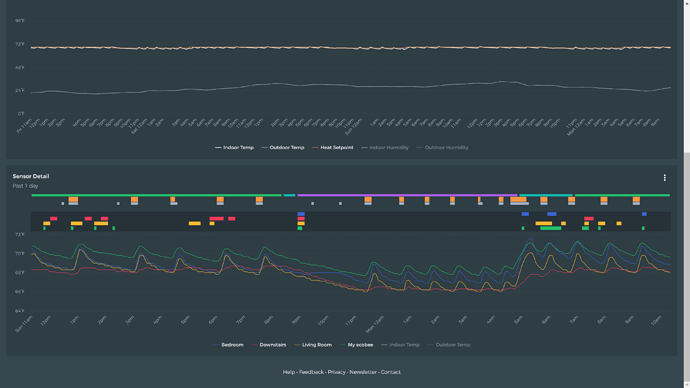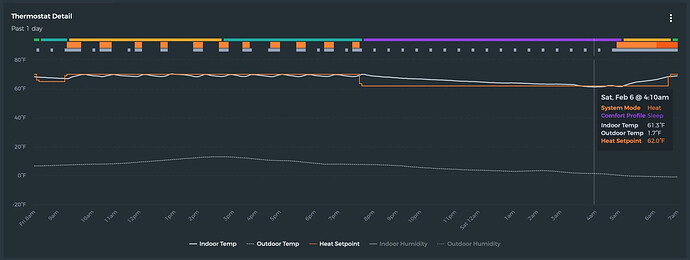Hello, say seeing my heat and resist are extremely flat, (they always have been)
my home heats well, I thought, regular gas furnace. rambler with a walk out basement. I had a company out a while back, blower in the door, and was told the house is extremely tight, and sealed well. we do have an air exchanger that runs on low all the time.
any thoughts or ideas looking at the data. thanks much for your time.
(sorry, I can only post 1 screen shot per post)
Gas heat systems are typically going to have heat profiles that follow the slope of the resist profile. They aren’t affected by the outdoor temperature so the amount of net heat put into your home is only affected by the amount of heat that is lost.
So the question is then…why is your resist so flat? Well:
I’d say that’s your answer. If your home is well insulated and sealed, the rate of temperature change in your home is going to be really slow. The heat (or cool) you put in tends to stay there so you get a nice flat profile.
Hey Joel,
I’m new here and just noticed your post as it relates to what I’m seeing in my data, now that I have a place to view it and learn. Right around Thanksgiving (2020) we decided to have a contractor come out and rip out ALL our insulation from our attic, then air seal the entire attic (2150 sq ft ranch, SE Wisconsin), lay down a 2" layer of spray foam in the entire attic, add any needed vents, then insulate to R60 with blown fiberglass on top of the spray foam. Additionally, we had them spray foam the box sills in the basement, and spray foam one corner (1/4 of the house) in the basement-where we are adding a bedroom and bathroom.
The week after that, we had a new Lennox furnace and AC unit put in with a 2 stage blower (first stage is 40% of the propane and electric usage as the second stage). Our goal: really minimize the amount of propane we use during the year (I simply don’t want to get hit with the higher bills).
Looking at my data, I have and EXTREMELY high resistance score now (379F), and a corresponding ‘virtually flat’ curve set, similar to yours. Granted, I only have like 8 weeks of data so far-as that’s all the longer that I’ve had my Eco Bee.
Here’s my plot so far.
I’m still trying to make sense of what all this is trying to tell me, so I’d appreciate any help possible with interpreting the data.
What makes the data even more interesting is this really isn’t quite as good as the house really is: we had an egress window cut through the basement wall, all sorts of contractors coming in and out of the house for construction, etc. We did have an instance where we had the fire department over because we ‘sucked in’ too many CO fumes into the basement during the egress install that it set off the detector (we also had a propane leak from moving the furnace). The fire dept commented on how air tight our house is-probably too tight, to the point that they suggested looking into an air exchanger. Not sure I know why I’d want an air exchanger after going through such lengths to keep the house tight for efficiency…
Anyway, hope this is useful.
Sean
Thanks very much for the information, guess I’ll get past the heat line, thanks for the feedback guys.
@smh77 that sounds like a great thing, we should do something as well in the attic, about 3200 sq ft rambler in twin cities minnesota. The spray foam in the attic . We have a venmar air exchange as well.
Was the company able to analyze or asses what areas or how ?? sounds like they did a great job!
my resist is 21f ?? and worse than 88% of the homes ??  that doesn’t sound good.
that doesn’t sound good.
seeing that makes me think some improvements can be made for sure. just not sure where to start.
attic insulation and spray foam might be a decent start.
thanks again for your time, much appreciated
Hey Joel,
Yes, the company we used (which has a 5 star rating in Google reviews) is a small company, but a guy who clearly puts his heart and soul into doing the right thing for his customers-he’s a great guy! He started with an initial consultation where he brought out his iPhone and walked around the house with me as I explained to him where our ‘cool spots’ were in the house. He had in IR adaptor for the phone and was showing me the dark spots on the joist, etc where we were clearly losing heat-it was really helpful to see that! He then climbed through the attic and inspected what was going on throughout. It turns out we had a lot of rolled, batted fiberglass insulation, with some cellulose blown over it (not consistently, and it was breaking down).
I asked what he recommended and he said ‘honestly, if you want to do it right: have us pull EVERYTHING out and start over’. So we did that. It took them over a full day to pull out all the cellulose and fiberglas batting. That night, the heat ran all night long (it was about 30F that night, if I recall). From there, installed the needed vents, and then they ‘air sealed’: which means they used spray foam to seal up at the top of all the top plates (near the soffits), tops of all the walls, over the can lights, and any other areas that were ‘leaking heat’. While he was at it, I asked how much more would it be to just lay down a complete layer of spray foam across the whole attic (target is 2"). He said it would be another $1500, so I said ‘do it’. So they proceeded to convert the air sealing into and air seal plus foam layer. We had already talked about finishing up with blowing in blown fiberglas to bring it up to R60 after that, which they did.
They also pulled out the batting from the box sills and spray foamed all of those. That was about $2100 worth of the cost. At the request of my contractor, I asked how much would it be to add the couple of walls in the basement where we were going to add the bedroom and bathroom: $500. At the end, it cost us $10,500 to do the whole project-and I don’t regret any of the money spent at all!
We set our heat down to 62F over night, and use a 1.5F differential for heating (so it would have to drop to 60.5F before the heat kicks on overnight). In short, it simply doesn’t run overnight any more! Below is last night’s plot, where the outdoor temp is now down to -1F (started at about +7F). Note: we’ve had to adjust the daytime setting to shutting off at 8pm (9pm on Fridays) just to ensure the house cools off some overnight as we have trouble sleeping if it’s too warm in the house. We also use the setting to have EcoBee figure out how long to run to bring the temp up by the time indicated so it predictively starts the stage 1 heat ahead of time to achieve the temp at the set time.
Hope that information is helpful? I can ask our insulator if he knows of anyone up in your area that he recommends-no guarantees, but he may.
Sean
Wow, thats great, looks like awesome results as well. thanks so much for the explanation.
sure, if you are in touch with them, we are in 55024, south east minneapolis st paul minnesota area.
thanks again
Air exchanger is important as it provides fresh air without losing heat. This ensures you don’t get condensation and mold issues.
@JoelS What sensors are you using?
I recently installed an ecobee with several smart sensors (new design). My sensors while positioned inches away from the tstat respond MUCH slower to temp changes than yours (3rd pic down from the top).
The blue sensor is positioned inches away from the tsat in this sample. My heat (traditional furnace) diff is .5F . At this rate, these sensors are pretty much useless for actual tstat control and more so for informational purposes only.







